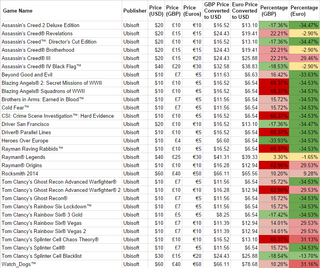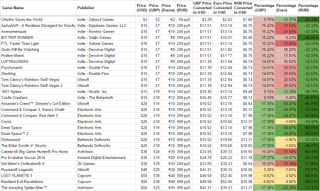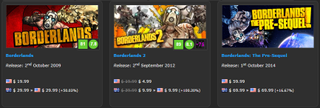The mysteries of AAA pricing
When it comes to pricing triple-A games across regions, there's very little rhyme or reason to explain why one region will be cheaper than the other. The biggest two factors I was able to find were that many Steam prices tend to follow their store-shelf retail counterpart, and that companies will tend to price for a single region first and then convert from there.
Most companies focus on the US market first and foremost,then deal with other regions secondarily, sometimes without much scrutiny. "We're heavily influenced by you goddam Americans," said Graeme Struthers of Devolver Digital, which has offices in both Texas and London, and publishes games from indie developers around the world. "For us it always filters back from the US dollar. That's always the starting and finishing point of that conversation."
In the past, this led to horrible methodology such as pricing a game "consistently" across regions—that is, pricing a $60, at £60 and €60, which ends up being terribly overpriced for the UK and EU. Things have mostly improved on that front, and it seems that most triple-A publishers—while they don't really have any consistency with OTHER publishers—are at least somewhat consistent within their own catalog.
The BioShock family from 2K Games, for example, are all priced at a 10/7/10 ratio between US/UK/EU (That is, BioShock and BioShock 2 are both priced at $20/£14/€20, with Infinite at $30/£20/€30, or the same ratio.)
Electronic Arts, on the other hand, mostly follows a 10/5/5 ratio, while Ubisoft is all over the board. Half the Tom Clancy series follows a 10/7/5 ratio while the other is 10/7/10, and the Assassin's Creed franchise is mostly split 10/7/7 and 10/5/5. In other words, who knows how they're doing things. (A Ubisoft representative was not available to comment.)
Ubisoft's price conversions don't follow an obvious pattern

The one thing that is consistent across all publishers, developers, and price points—both triple-A and indie—is that games are cheaper in Russia. (As well as Brazil and other regions that have only recently been added to Steam.) Significantly cheaper. Like, 30% to 70% cheaper, across the board.
This is due, again, to a number of factors. The Russian ruble was only added as an accepted currency to Steam in 2011. Before that, purchases on the Russian Steam store had to be made via credit card in US dollars—credit cards are not as common in Russia, and the ones that do exist often weren't able to handle transactions in other currencies. After the Ruble was added, those with credit cards could start buying, but it wasn't until Valve added additional payment methods, such as setting up payment kiosks where funds could be added to a Steam wallet, that the service became a popular choice. What this means is that, up until the last two or three years, most Russian PC games were still purchased at brick-and-mortar stores, and historically Russian software was priced by the disc.
The biggest gaming news, reviews and hardware deals
Keep up to date with the most important stories and the best deals, as picked by the PC Gamer team.
"A one disc game was $4. Two discs: $8, and the market simply wouldn't stand much more than that," Wilson said, joking how Tripwire's game Red Orchestra sold very well in the Russian territories since it's one of the few games where Russians get to shoot Germans. "We were aware that the Russian market was simply not willing to bear the prices we pay, so if we were going to sell successfully online, we had to compete with the existing retail market on store shelves. If the market has Red Orchestra at $8 on the shelf, you can't price it at $20 online."
Always cheaper in Russia

This explanation applies to other recently-added regions and developing countries—the market simply cannot support the prices we pay for video games. Rather than lose sales to piracy, the logical move is to adjust prices to a level more affected by the market demand and sustainability than the direct exchange rate.
Russia also has a notorious reputation for software piracy—Russia pirated 63% of its software in 2011, as compared to 19% in the US and 26% in the UK, according to a global study—a figure which is echoed in other countries with developing economies. However, this may not have as much bearing on the country's low prices as you might think. According to Valve boss Gabe Newell, piracy is an issue of service, not pricing.
"The easiest way to stop piracy is not by putting antipiracy technology to work. It’s by giving those people a service that’s better than what they’re receiving from the pirates," Newell said in a 2011 interview with GeekWire, noting at the time that, outside of Germany, Russia is Valve's largest continental European Market. "The people who are telling you that Russians pirate everything are the people who wait six months to localize their product into Russia."
Interestingly, the opposite effect seems to have happened in Japan. Steam prices are again affected by the brick-and-mortar shelf prices, but games on Steam—the few that even make it there in the first place—tend to be priced higher. PC gaming is extremely niche in Japan, but within that niche is a market of buyers willing to pay upwards of the Yen equivalent of $70 or $80 for a game. Many companies don't want their game on Steam, because they don't want to reduce the price to match the sale prices targeted at western gamers. The few games that do make it onto Steam then have their prices dictated by the store shelf prices—companies don't want their niche brick-and-mortar sales to be cut into by lower prices online.
"They want those $70, 80 dollar sales," said Esteban Salazar, a producer at Japanese developer Marvelous AQL. "It’s very, very focused, laser targeted, towards the core group of a few thousand people that would buy, rather than a huge mass market audience like the store overseas."

Compare this to the Australian market, where taxes keep the price of imported games locked in higher than their overseas counterparts. It's expensive to ship games to distribute games in Australia, and publishers have claimed in the past that selling new AAA games for less than $80 AUS would not be profitable. Publishers typically keep Steam prices even with retail prices, which means Australian Steam games almost always feel unfairly expensive to Australian PC gamers. Ubisoft recently offered the explanation that “unlike Ubisoft US, Ubisoft Australia & NZ is a part of the European business group...We buy and sell product at euro-based cost of goods and royalties, as does UK, France and most of continental Europe.”
On the next page: the increasingly digital future of game sales.
PC Gamer is the global authority on PC games—starting in 1993 with the magazine, and then in 2010 with this website you're currently reading. We have writers across the US, Canada, UK and Australia, who you can read about here.
Most Popular


